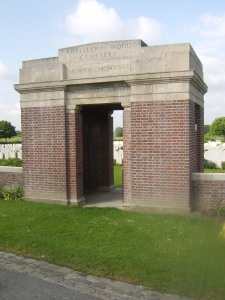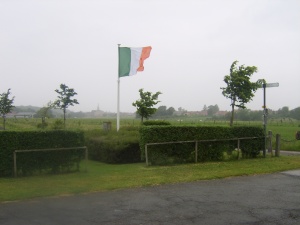
Two military graves lying only feet apart in a Belgian cemetery commemorate the lives of two iconic literary figures: the greatest Welsh and the greatest Irish poets of the Great War.
They died on the same day in the same battle, but the paths that led them into British Army uniform could not have been more different.
Elis Humphrey Evans – “Hedd Wyn” – was born into a farming family in Trawsfynydd. The war had torn open a split in Welsh non-conformism, causing a major clash between those who opposed and those who supported the conflict.
His poetry, which was inspired by the Romantic work of Shelley, quickly began to tackle the subject of the war. He wrote his war poetry before he enlisted.
Hedd Wyn was a Christian pacifist, but he joined the British Army so that his younger brother would not have to fight.

Francis Ledwidge is known in Ireland as the “poet of the blackbirds”. Born into a poverty-stricken family, he became a political activist and union leader while still a teenager. His poetry earned him the patronage of Lord Dunsany, who introduced him to WB Yeats.
A keen patriot and nationalist, he joined the Irish Volunteers, a pro-Home Rule force. On the outbreak of war the Irish Volunteers became split between those who supported the British cause and those who did not.
Ledwidge initially opposed the war but changed his mind, believing that if Britain won the war Ireland would get its Home Rule. He said he could not stand by while others fought for Irish freedom.
The stories of these two men’s “paths to glory” and violent death are set against the backdrop of the history of the Edwardian and First World War Wales and Ireland: the 1904-05 religious revival, the power of the Chapel to oppose and support war, Irish Catholicism and Nationalism, the Easter Rising and the promotion of the war as a Christian fight against paganism.
In Wales, whilst poet T Gwynn Jones and Socialist preacher TE Nicholas were campaigning against the war, the chapels with the help of ministers like John Williams, Brynsiecyn, ensured the youth of Wales enlisted in their thousands.
In Ireland, Nationalism developed into a failed revolution. But Ledwidge now considered himself a soldier and wondered in his poetry if he would have a soldier’s death.
On July 31, 1917, on the opening day of the Third Battle of Ypres, a shell landed in the trench where Ledwidge was drinking tea. His chaplain recorded: “Ledwidge killed, blown to bits”.
Nearby, as Hedd Wyn – who had only recently arrived at the front – advanced with his comrades on Pilckem Ridge, the Welshman was struck down. He died soon after at a first-aid post.
The Birkenhead National Eisteddfod of 1917 became known as “Eisteddfod y Gadair Ddu” in recognition of Hedd Wyn’s being awarded the Chair for his long poem, Yr Arwr. He is regarded as the iconic Welsh poet of the First World War.
In Ireland, the thousands who had died for the British Army – people like Francis Ledwidge – were forgotten. It was said by leaders of the new Republic of Ireland that although their sacrifice was great but they “did not die for this State”.


